Butterflies
Of all the insect groups, butterflies are perhaps the best known and best loved. They are innocuous, often brightly-colored and often easy to study at close quarters. Cape May has as interesting butterfly fauna that
includes resident, migratory and vagrant species and - weather permitting - it is even possible to see at least one species any day of the year.
Butterflies and moths together form the order Lepidoptera and it can be difficult to set out definitions that completely separate the two groups, with skippers in particular having many moth-like traits. All butterfly species
fly during daylight hours but odd individuals may sometimes be attracted to lights at night.
At this stage, be sure to read the text next to the pictures and go for the best match, as the next stage will help you get to the exact species.
(For a list of all butterfly species on the site, click here)
Use the photos below to narrow your search to a group of butterflies, then click on the picture to go to the next stage.
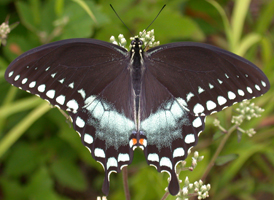 |
Swallowtails
Relatively large butterflies with predominantly black or yellow wings, often with red spots on the underside. |
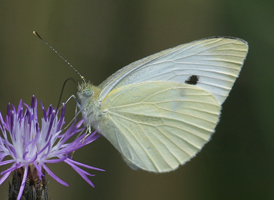 |
Whites
Predominantly white, small to medium-sized butterflies, usually with a few darker spots or dusting, especially on the underside of the hindwing. Usually found in fields and other open,
grassy or weedy places. |
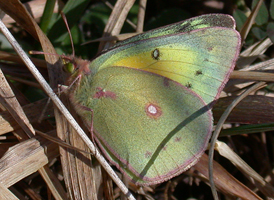 |
Sulphurs
Predominantly yellow or orange-yellow, small to medium-sized butterflies, sometimes with a blackish border and usually with darker markings on the underside of the hindwing.
Usually found in fields and other open, grassy or weedy places. |
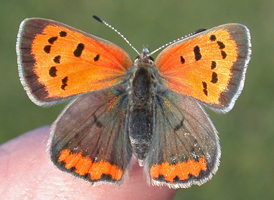 |
Coppers
Small, low-flying butterflies of fields, bogs and other open habitats. Mostly bright, shiny orange with browner patches. Most are pale, often chalky white, below. |
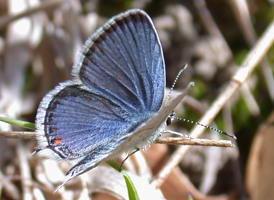 |
Blues
Small, low-flying butterflies of fields, backyards and other open habitats. Males are mostly bright blue, females may be blue or grayish. Most are pale, often chalky white, below. |
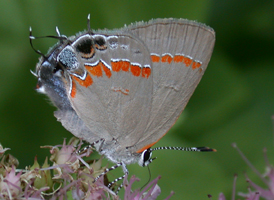 |
Hairstreaks
Small butterflies that are mostly found in wooded areas, but sometimes species are readily attracted to flowering bushes in good numbers. Most species settle with wings closed together and have often
very intricate patterns on the undersides. Mostly pale grayish with darker markings; often with 'tails' on the hindwings. |
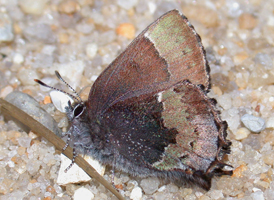 |
Elfins
Small, brown hairstreaks that may be easily overlooked as day-flying moths. Most often found taking salts from dirt roads on warm late spring or early summer days in wooded areas. |
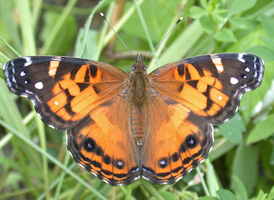 |
Brushfoots
A large group of mostly medium-sized butterflies. Color highly variable between species with most being predominantly orange- or pinkish-brown with darker markings and often eyespots. Some are mostly
blackish, often with red or blue markings. Most species settle with wings open, but will often feed at flowers with wings closed. |
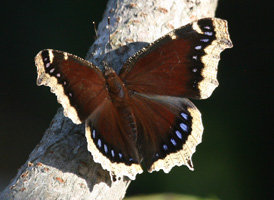 |
Brushfoots
A large group of mostly medium-sized butterflies. Color highly variable between species with most being predominantly orange- or pinkish-brown with darker markings and often eyespots. Some are mostly
blackish, often with red or blue markings. Most species settle with wings open, but will often feed at flowers with wings closed. |
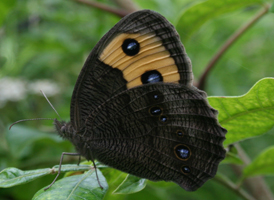 |
Satyrs
Small to medium-sized, mostly brown or gray-brown butterflies which generally favor woodland. Most species have at least some eyespots on the wings. Mostly settle with wings closed, but will sometimes bask with
wings open in patches of sunlight. |
 |
Monarchs
Relatively large butterflies, the vivid orange and black monarchs are perhaps the best-known of North America's butterflies. |
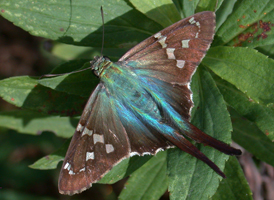 |
Large Skippers
Small but chunky butterflies with pointed forewings and sometimes with tails. Mostly brown with lighter or darker markings. Butterflies of open habitats that occur as immigrants from the south, so
numbers vary from year to year. |
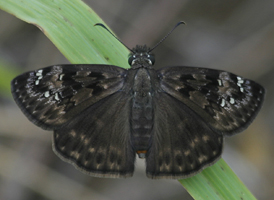 |
Flatwings
Small butterflies that mostly (but not always!) rest with the wings held out flat. Most are dark, blackish-brown butterflies but some are lighter grays or even have white markings. |
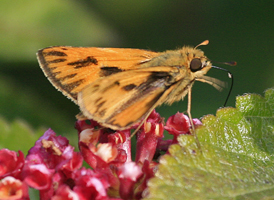 |
Skippers
Our largest group of butterflies and often difficult to identify due to their fast, skittish flight. Small butterflies that are predominantly a mix of browns and orange-browns, often with
intricate markings on the underside of the hindwing. Mostly found in open, grassy fields or swamps. |